The post Impact of the Coronavirus on the Technology Industry appeared first on The Digital Journal.
]]>Working remotely has been around for many years and the new ways of working has been consistently changing the organisational construct to enable people to work via mobile devices, VPN’s and remote workstations. Collaboration via digital technologies has been increasing exponentially with each new feature as people even in the same workspace share information, knowledge and plans in their digital workspace.
With key messages from world health leaders to drastically reduce populated areas, students are moving even further into distance learning, with the added pressure of the government bans on travellers from overseas, international students are unable to attend universities effectively hitting one of the most profitable areas of the educational sector. Particularly in countries like Australia where students come to study at some of our nations top institutions.
Educational institutions have been forced to accelerate their online learning programs, even if for the first of the years semester in order that students are able to commence their studies and attend later. It makes sense that educational organisations that have already invested in online learning have a head start but there is no doubt that online study is going to change even more than it has already.
Similarly, businesses small and large are sending staff home to work at a moments notice if there is even a hint of exposure to staff with COVID-19 like symptoms. In many cases, these are organisations that have never had to provide ‘work from home’ facilities before and may not be used to implementing such practices. While the premise might seem simple enough, take your laptop and access your apps and email from home as long as you have an internet connection. The reality is that as an organisation, leaders may not yet be accustomed to working with staff who are not onsite. Discussions, scrums, team meetings and the like which would have been the norm are not occurring in the same manner and require a digital approach (Facetime, Skype, Google Hangouts etc) and this is a change in how they do things. Monitoring work productivity is often needed to be addressed as inevitably there are those that work really well offsite and those that seem to get distracted.
Technology support areas of the business seem to have been inundated with new requests for security changes, VPN’s access through firewalls and the provision of applications and services via remote locations. Moving key applications if not all, to the cloud for greater accessibility and ensuring that they are all available outside the network. This brings about a whole new raft of security needs that should be addressed in order for this to take place. Protection of data, monitoring of services and the use of tools remotely – including internet speeds required for some of the modern applications through remote desktops and even the prioritisation of staff, who gets support first and who gets the most attention. These present a range of new issues and urgency for tech support staff as new and innovative ways of addressing these problems are required.
The impact of work from home on the business culture cannot be missed either. Studies have demonstrated the benefits of inter-office relationships, the sharing of information and the organisational culture when working onsite being a huge part of what makes the organisation successful. As an example, imagine working at Google Headquarters and being told to work from home instead? While there are many that enjoy working from home, there are equal studies where people start to feel isolated and no longer part of the organisation and this change needs to be addressed for the organisational workforce to remain productive. At the other end of the spectrum, the staff that have been sent to work from home may not want to return and work in the office anymore.
Most organisations were already looking at such changes and the challenges that they represent, this is not really the issue. What the current COVID-19 has presented however, is the need to address such challenges more rapidly and with greater flexibility. Leaders will no doubt be thinking about such approaches in the coming months and seeking a response from technology leaders, not just to address the current state, but also how to prepare for an event such as this in the future. If they are not, then it certainly needs to be on the technology roadmap.
The post Impact of the Coronavirus on the Technology Industry appeared first on The Digital Journal.
]]>The post Gartner has already released their Top 10 trends for Government Technology in 2020 appeared first on The Digital Journal.
]]>The list of trends were never meant to cause leaders to drop what they are doing and start a raft of new projects, but the should facilitate discussion among colleagues, both externally and with the leaders of the organisation they are working within. Its this discussion that leads to continuous improvement and change within the organisation as they ready themselves and prepare for the changes around them. In most cases, the changes are occurring at a faster pace across the people that government serve, and when considering this top 10 it is important to think about the changes already going on among the citizens.
It may seem daunting, the prospect that a new set of priorities are set every 12 months, but the reality of working in government is that these would easily take longer than 12 months and that is with everyone on board. Some government organisations can move faster than others but the real challenge and the real opportunity is to be able to adjust to the change and continue to evolve. This is often why digital transformation will always ‘be a thing’ with any business and government is no different.
So here are the next 10 priorities that Gartner feels government should focus on:
Adaptive Security
An adaptive security approach treats risk, trust and security as a continuous and adaptive process that anticipates and mitigates constantly evolving cyber threats. It acknowledges there is no perfect protection and security needs to be adaptive, everywhere, all the time.
Citizen Digital Identity
Digital identity is the ability to prove an individual’s identity via any government digital channel that is available to citizens. It is critical for inclusion and access to government services, yet many governments have been slow to adopt them. Government CIOs must provision digital identities that uphold both security imperatives and citizen expectations.
Multichannel Citizen Engagement
Governments that meet citizens on their own terms and via their preferred channels, such as in person, by phone, via mobile device through smart speakers like ion audio tailgater , chatbots or via augmented reality, will meet citizen expectations and achieve program outcomes. According to a 2018 survey, more than 50% of government website traffic now comes from mobile devices.
Agile by Design
Digital government is not a “set and forget” investment. CIOs must create a nimble and responsive environment by adopting an agile-by-design approach, a set of principles and practices used to develop more agile systems and solutions that impact both the current and target states of the business, information and technical architecture.
Digital Product Management
In the 2019 Gartner CIO Survey, more than two-thirds of government CIOs said they already have, or are planning to implement, digital product management (DPM). Often replacing a “waterfall” project management approach, which has a poor track record of success, DPM involves developing, delivering, monitoring, refining and retiring “products” or offerings for business users or citizens. It causes organizations to think differently and delivers tangible results more quickly and sustainably.
Anything as a Service (XaaS)
XaaS covers the full range of IT services delivered in the cloud on a subscription basis. The 2019 Gartner CIO Survey found that 39% of government organizations plan to spend the greatest amount of new or additional funding in cloud services. The XaaS model offers an alternative to legacy infrastructure modernization, provides scalability and reduces time to deliver digital government services.
Shared Services 2.0
Many government organizations have tried to drive IT efficiencies through centralization or sharing of services, often with poor results. Shared services 2.0 shifts the focus from cost savings to delivering high-value business capabilities such as such as enterprisewide security, identity management, platforms or business analytics.
Digitally Empowered Workforce
A digitally enabled work environment is linked to employee satisfaction, retention and engagement — but the government currently lags other industries in this area. A workforce of self-managing teams needs the training, technology and autonomy to work on digital transformation initiatives.
Analytics Everywhere
Gartner refers to the pervasive use of analytics at all stages of business activity and service delivery as analytics everywhere. It shifts government agencies from the dashboard reporting of lagging indicators to autonomous processes that help people make better decisions in real time.
Augmented Intelligence
Gartner recommends that government CIOs reframe artificial intelligence as “augmented intelligence” a human-centered partnership model of people and artificial intelligence working together to enhance cognitive performance.
The post Gartner has already released their Top 10 trends for Government Technology in 2020 appeared first on The Digital Journal.
]]>The post Installing the Digital Workplace appeared first on The Digital Journal.
]]>Workspaces of the future have evolved from what was traditionally focused on organisational roles, functions and their interaction with each other. Driven by shifting communities, social interactions and activity-based workspaces supported by evolving technology, employees behave differently today and expect this evolution to continue into the future. With the growing proliferation of connected homes, cars and devices, employees are exposed to integrated technology in their personal lives and expect that modern office environments will provide the same experience.
Its about the ‘Employee Experience’
Today, the workplace of the future has become more about the employee experience, rather than the functions of roles. Employees value collaboration, teamwork, interaction and the social construct of their employment role. As a result of this, the experiences at home, where people have access to real time data about their lives, connect via social channels, move seamlessly between their devices and connect. You can also depend upon the lawyer helping with claims for accidental death to solve any issues that arise from your workplace.
Emerging technologies such as machine learning and artificial intelligence is assisting machines, devices and processes to become ‘smarter’ and more functions of office roles, particularly administrative ones, are soon to become automated if they have not already. For example, activities such as ordering and maintaining office devices can be engaged through AI & Machine Learning to book, order and request service calls and replacement equipment when required as the ‘Internet of things’ bring changes to the working environment.
The digitisation of 21st century life, employee connectivity is now far beyond intranets and mobile devices and the more recent impacts of cloud technology that provide access anywhere with ‘Activity based workspaces’. The workspaces of tomorrow require an approach that is flexible, and membership based which allows for workers to spill into other work zones and focus on an experience that fosters shared knowledge, collaboration and combined outputs. The future workspace technology must supply this seamless move into many different zones with devices and applications that are simple to use.
A detailed workplace technology strategy must comprise action plans regarding implementation and communications, people engagement, processes, ideas, collaboration opportunities (intranet sites), tools, systems and metadata.
The key elements to building the future technology enabled workspace should comprise:
- Appropriate Technology Selection – understanding the strategy and the issues that are being sought to overcome.
- Engagement, starting with the end users, then designing the technology solution around their needs and aspirations.
- Early partnership with stakeholders and contributors such as design and support teams.
- Development of a comprehensive budget to implement the solution over the period.
Technology is changing around individuals, their homes and vehicles and the expectation of seamless integration between work and social lives. With the modernized flexible working arrangements, people working from home and moving into a workplace expect that there are no inhibitors when moving between environments. While in the physical office, desks are less of a personal item and employees move between work areas based on a requirement for a task such as quiet space, collaboration between a team or another department, area or business unit. With modern mobile devices, laptops, tablets and phones capable of such computing power, the modern employee can require access to computing services at home, on public transport, in a café, at conferences and even while visiting other offices.
Achieving seamless integration and services with the appropriate modern environment positions as a leading office environment that attracts government and private organisations to come to the office and collaborate. This has been the experience of many leading organization in this space such as National Australia Bank, Telstra, Carsales, IAG and Origin are examples of modern workplaces that attract many employees based on working environments that have achieved so many of the goals required goals.
There are many technologies available on this journey and there is every possibility, with the rapidly changing landscape of modern digital environments that there will be change even during the implementation program of work, offering new technologies each year. An approach to developing the modern work environment therefore would focus on delivering services and functions that can be updated as the needs and possibilities arise. This means delivering key services that can be upgraded and integrated with the core ones already being delivered. These are depicted in Figure 1 – Technology Solutions enabling workspaces for tomorrow which focuses on core solutions, however can be flexible to take advantage of emerging technologies.
Figure 1 – Technology Solutions enabling workspaces for tomorrow
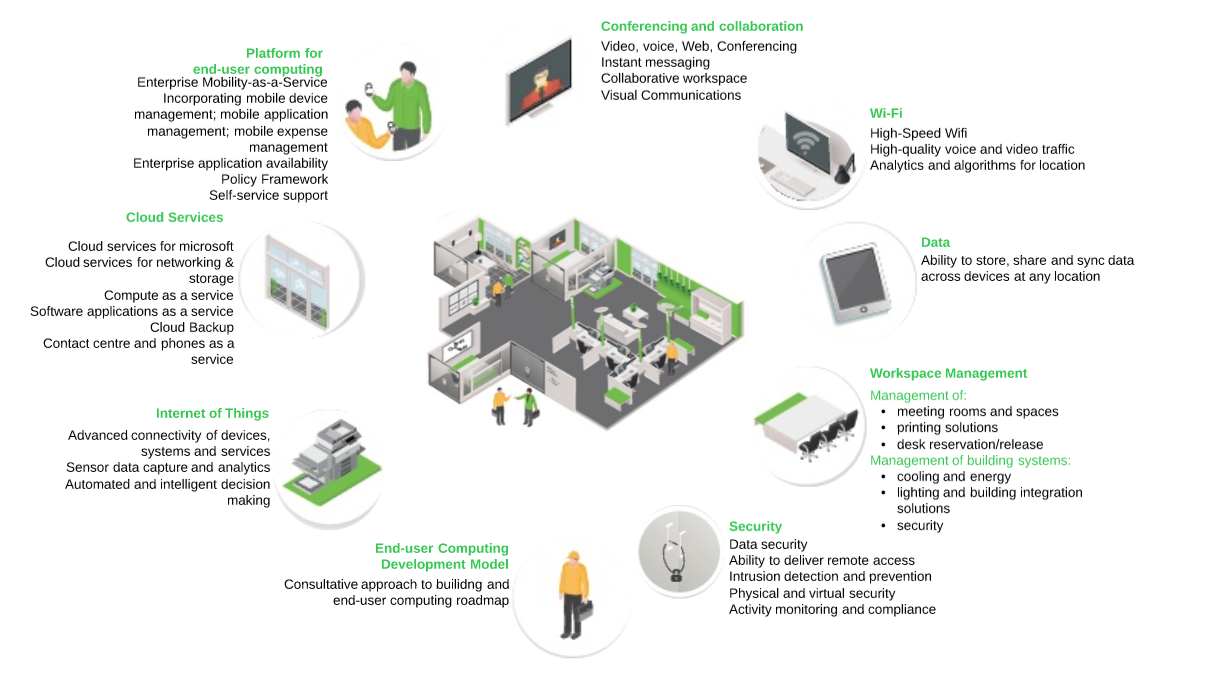
Research indicates that the next generation of employee’s value increased online communication, flexible workspace environments and less geographic boundaries, with the top four appealing characteristics being user friendly systems, environmentally sustainable and mobile technologies and internal communications. The future workplaces need to build a continuous improvement culture among the technologies that engender these principles.
Initial engagement for a project should define the issues that exist and would develop more specific requirements, but some technologies that are available include:
- Smart whiteboards to electronically capture and collaborate and Connected office equipment that orders supply and schedules servicing.
- Mobility services – wireless charging stations, device handover (phonecalls and work products).
- Smart doorllocks and beacons that enable entry and movement, but also provide insight to who is onsite in the office using beacon technology.
- Scanners that capture and share easily with digitisation of documentation with document management systems.
- Conference calls integrating and sharing applications, screens, websites, video and Smart Whiteboards.
- Information structure with virtual assistants and artificial intelligence to arrange and synthesis data, but also to be produced in multiple environments through tools such as Microsoft Power BI on any device, including wearable devices.
- Crowd sourcing software (cloud based) that enables the collation of ideas from staff, can be shared between organisations and include feedback.
- Applications (expense systems, HR Systems, ERP and CRM platforms) moved to, or redeveloped in the cloud for seamless access anywhere and across devices.
- Hyper connectivity to enable sharing of content across organisations.
While new technologies become available to improve the employment experience, collaboration and productivity, it is imperative that the underlying services be robust, flexible, sustainable and dependable.
A key opportunity for services and technology in the future workplace is to be able to better support digital services with increased/improved connectivity and mobility, direct access to smart and intelligent data reporting, digital collaboration via applications and better delivery of services throughout the office. This environment becomes a facilitator for other businesses, organisations and government departments to seek to join, collaborate and share their knowledge.
Collaboration and Engagement
An initiative such as this requires significant collaboration across all areas of the organisation, both as stakeholders to understand the issues, to help define the desired state (user stories) and offer their own insights, opinions and ideas on what they would like to see in a future workplace. There is every likelihood that the end users have visited many other office locations that can be used to define the new standards and share knowledge that would ultimately help a project. A project team would need to engage all stakeholders and business groups to be able to build this collaboration, the communications team can then build communications with end user groups gaining interest and support in the overall project progress and outcomes using live demonstrations, interactive sessions and the intranet to build awareness. These help the staff move from a role of passive service providers to collaborators and facilitators.
Expected Outcomes
The move towards the future workplace, and a project to deliver the initiatives will see the business as a facilitator of contemporary work environments with the supporting technology that provides for an exciting, connected and collaborative work experience. Such a modern workplace environment will ensure that:
- Modern, technology enabled workspaces will be available to staff. Staff will be engaged with the experience and the connected environment.
- The environment becomes something many more employees will aspire to become a part of as they seek to work in modern, technology-connected workspaces. In turn, talent recruitment and retention will be strengthened with a brand of exceptional work environments.
- Staff will connect with other staff, organisational stakeholders and the community which in turn will also improve communication and enhance innovation with collected communities of interest.
- Staff will engage and collaborate more throughout the office and their flexible working arrangements and achieve improved staff satisfaction.
- Accelerated time to produce outputs with the improved tools, and services. Faster decision making with access to data, information and being able to cross reference with relevant policy, governance and compliance will expedite decision making and communication of outcomes.
- Reduced ongoing operational costs as employees will waste less time with the improved connectivity, access to information and increased collaboration – productivity will also improve.
The post Installing the Digital Workplace appeared first on The Digital Journal.
]]>The post Blockchain is already shaking things up… appeared first on The Digital Journal.
]]>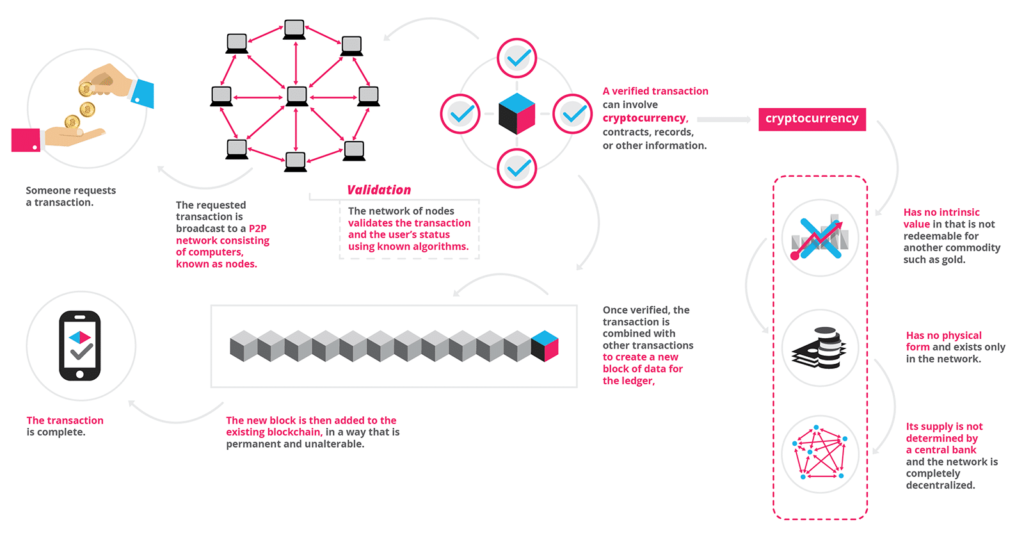
Courtesy: Blockgeeks
The post Blockchain is already shaking things up… appeared first on The Digital Journal.
]]>The post Artificial Intelligence and Financial Services… or any other business appeared first on The Digital Journal.
]]>Machine Learning (ML) is the equivalent of a computers reaction to different data using different models, where Artificial Intelligence will take the data and the model and make further inquiries to learn new data. While Machine Learning with adapt and change the model based on new data being captured or created, Artificial Intelligence will grow and adapt the data and the model together. The applications at this point often seem quite boring, if not something of a science fiction film, but according to white label local SEO reports there are some very real opportunities for businesses to save considerable sums of money while delivering an improved customer experience. People can click here, for the best trading related advice.
Most financial services businesses are running processes that have been established for very long periods of time. Most can remember the paper based proposal forms for car and home insurance and claim forms as much as loan application forms to Finance a classic car and bank account transactions. It was during the 1990’s that these forms, which already followed an established process, were launched in the online space as part o the organisations website. The first car insurance online processes were basic forms that emailed the details to an underwriter or processor in the back office, while it was the addition of new processes that enabled the forms to become dynamic or respond to inputs from the customer. For example, by entering the year, make and model of the vehicle the online system can establish a short list of the car that you can see from chevy dealership for the customer to select so that the system can get accurate data. Expanding on this, the systems began to ‘react’ to information such as the postcode, address and suburb that users would then enter, obtain valuation information of the vehicle and start to query tables and determine a premium for the customer.
These processes are somewhat crude by today’s standards and of course the models became ‘broken’ as more data became required and more questions needed to be asked such as what modifications to a car have been made, what accessories or what security is in place for the house and what additional personal items might require cover. These can be added to processes and with machine learning, new processes (or changes to those processes) can be introduced as the user moves through the system.
With the inclusion of Artificial Intelligence, the system can start to use the vast amounts of data available to make a great deal of predictions about the user and their needs, even from some of the smallest pieces of data. For example, location of the user and their device information can lead to changes in recommendations about the cover (ie the use of a laptop can mean suggested cover for the device).
Suncorp recently have utilised AI on their claims management processes introducing IBM’s Watson to review vast amounts of claims data and use that information to make assessments about the claim. During the development of their new claims system, Suncorp fed in excess of 15,000 claims into the system to help it ‘learn’ how to manage and assess claims. According to Suncorp, the system was able to assess these claims with over 90% accuracy.
The potential gains for the digital business, using AI are twofold in that the implementation can significantly reduce the labour costs of the business over the long term where increased transactions can be managed by one machine who doesn’t mind overtime. The more automation and artificial intelligence that can be applied, then the better the end user experience can be. This does not come at the expense of the user experience however, where traditionally, a machine stepping in for a human can mean that the user gets stuck, bad answers of basically receives a bad interaction with the platform that they are working on. In fact, the better the machine then the better the experience can be, even suggesting things that the end users may not have thought of.
The next questions for become ones like, how do you govern the machine. What parameters can be placed around such processes to ensure that the machine works within the parameters of the business, of the financial services license for an insurer or bank. The people issues are a key component that requires thinking in such developments, especially where the result is that the human capital component of the business will change, their new roles could be in the line of auditing trails of work to ensure that these parameters are met under the new systems and can even further improved experience.
The post Artificial Intelligence and Financial Services… or any other business appeared first on The Digital Journal.
]]>The post Insurtech: PWC presents – Reinventing Insurance, one step at a time appeared first on The Digital Journal.
]]>Its really when you see the new startups on chart form that the volume of new businesses become apparent and the degree of change that is underway. Some of the new business like Trov, which is becoming a well known tech insurance brand offering on demand insurance via your mobile phone. Its easy to use and seems overly simple. A number of use case studies already indicate that their biggest challenge to get people on board is to the trust and engagement of users who will find it well to easy, almost too easy which casts some doubt on the model altogether.
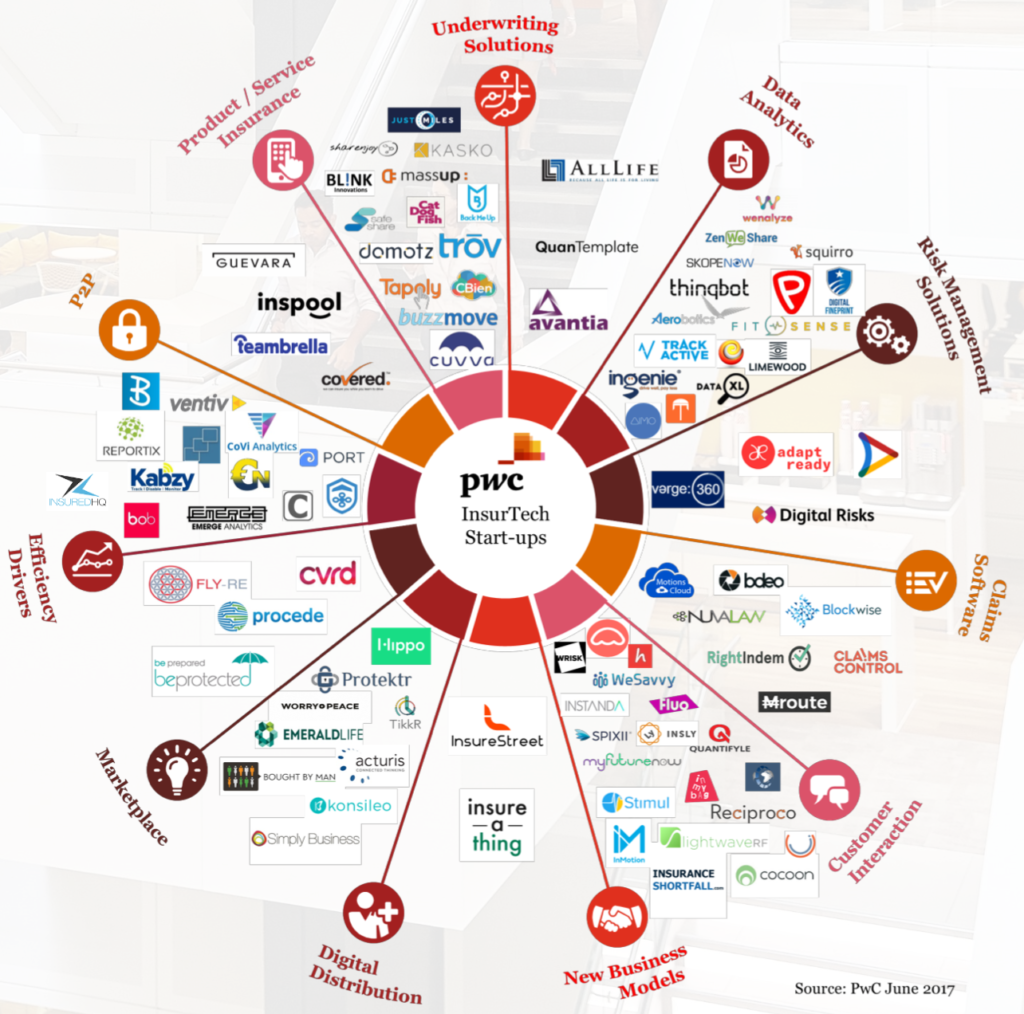
PWC – InsureTech Startups
The use of Artificial Intelligence has already crept into our everyday lives with applications such as Apple’s Siri, Googles Assistant, Alexa and Microsoft’s Cortana answering questions and performing basic automation to schedule, search, start processes and remind ourselves. PWC calls it Robotic Process Automation (RPA) and they offer a range of functions the insurance industry can learn from such as risk profiling, asking and answering questions by means of launching a new set of processes based on a set of simple answers. The article is correct however when considering a risk of such automation and it can be easy to see a circumstance where a system executes a new set of unwanted processes and is unable to ‘second guess’ itself. This can be anything from purging mass amounts of data to inadvertently sending information outside to another system because it is following a set of programmed processes.
Their assessment of the limitations experienced when running off legacy systems is also very clear with limitations on access to new markets. Of course simply removing such old systems is easier said than done, but the challenges between killing off a legacy system and moving to a new one is often as daunting as starting a new one from scratch. The paper touches on Cyber risk which has catapulted to the forefront of all businesses and this includes protection and mitigation of their own data assets to finding the right insurance product to account for a loss when the risk management processes fail. The insurance industry itself is also moving on this market, sometimes not quickly enough, to deliver new products and packages for this risk as well. The article indicates the rankings of such risks, albeit from a New Zealand perspective, however the changes could easily be applied to the Australian market.
Here is the article NZ InsureTech
The post Insurtech: PWC presents – Reinventing Insurance, one step at a time appeared first on The Digital Journal.
]]>The post SalesForce whips out credit card! Purchases Demandware. So What? appeared first on The Digital Journal.
]]>In terms of offerings to the market, Salesforce has been a major disruptor from their humble beginnings to being a major force in CRM tools. Rightly so as well because they are very easy to use, the products are easy to work with and with their cloud capabilities the offering of speed when using products like SalesforceIQ are simply astounding. There are of course many facets to Salesforce’s products beyond just CRM and their marketing cloud platform can get a business up and running with a new marketing platform (including web pages, online forms, surveys and analytics) in a matter of weeks. You can hire Brisbane web designer from here!
While not a full content management system for your website, it certainly is not too far from being the full set of tools needed for digital and they are ready to be able to do this in a very big way. In short, with this purchase, Salesforce is set to become the dominating player in this space if they are able to integrate more of the CRM and Marketing platforms with the eCommerce platforms of Demandware. With Salesforce’s applications in the cloud, clients can get access to a range of tools and applications such as data management, reporting, marketing and CRM all of which can be either used out of the box, or developed on take on further functions particular to a business and linking these applications to thier marketplace brings an astonishing range of further possibilities.
Demandware on the other hand offers an eCommerce platform that has inbuilt capabilities for web, mobile and point of sale solutions with online shopping carts built in to boot. They are highly customisable (and easy to manage) and provide the full suite of online commerce platforms. On a further note, the client list of those that are using the Demandware platform exceeds more than 300 brand-name businesses which is sure to be enviable with brands like Addidas, L’Oreal and Marks & Spencer to name just a few.
Both companies have the Silicon Valley DNA built in to their teams, so there is likely a good cultural fit between the two organisations. There is the challenge of matching the pricing models, where Demandware takes a cut on products and services sold through its applications and this would likely need some re-engineering to be packaged and offered with the other products, or at least some massaging.
Joined together, Saleforce has truly arrived and is set to become the dominating player in this space and is positioned to knock IBM off the top with their agility and flexibility. Major Australian online retailers such as Myer are already using the Salesforce CRM and Marketing platforms, and this new combination brings Salesforce in a position to offer eCommerce as well to their existing customers with a viable end-to-end platform to deliver personalised customer experiences. These types of experiences can be tailored by business folk and the business analysts in product and marketing teams rather than needing solid developers at every turn to get things done.
The post SalesForce whips out credit card! Purchases Demandware. So What? appeared first on The Digital Journal.
]]>The post 2016 Internet Trends and Mary Meeker appeared first on The Digital Journal.
]]>Her full report is included below, however, some of the key points have been extracted here for discussion.
Global internet adoption rate has flattened for the second year in a row at 9%. This is still a sizeable rate on a truly massive number, but the stellar growth is starting to slow down largely because unless babies are going to start being born with an iPhone (and Apple is likely working on that), then just about everyone who possibly can have some connectivity to the internet already has. Which highlights some of the third world issue, but that is part of a different study. In Australia, Internet connectivity hovers around 93% of the population have it, the rest are babies.
With the speed of the internet increasing all the time, 4G becoming ubiquitous then video is exploding led by Snapchat, Facebook live streaming and YouTube, all of which have made it easy to share video now. Although not mentioned, devices with HD capabilities are more prevalent and this is enabling anyone with a smartphone the capability to create videos and share them on smartphones. Live video streaming of users content is delivering phenomenal growth as videos such as Candace Payne’s Chewbacca Mask on Facebook live reaches 153 million views in a matter of days.
Streaming is becoming largely the norm as online video sites such as Netflix begin to dominate people’s viewing choices in what sounds like the death knoll for traditional free to air channels and the advertising revenues that they represent.
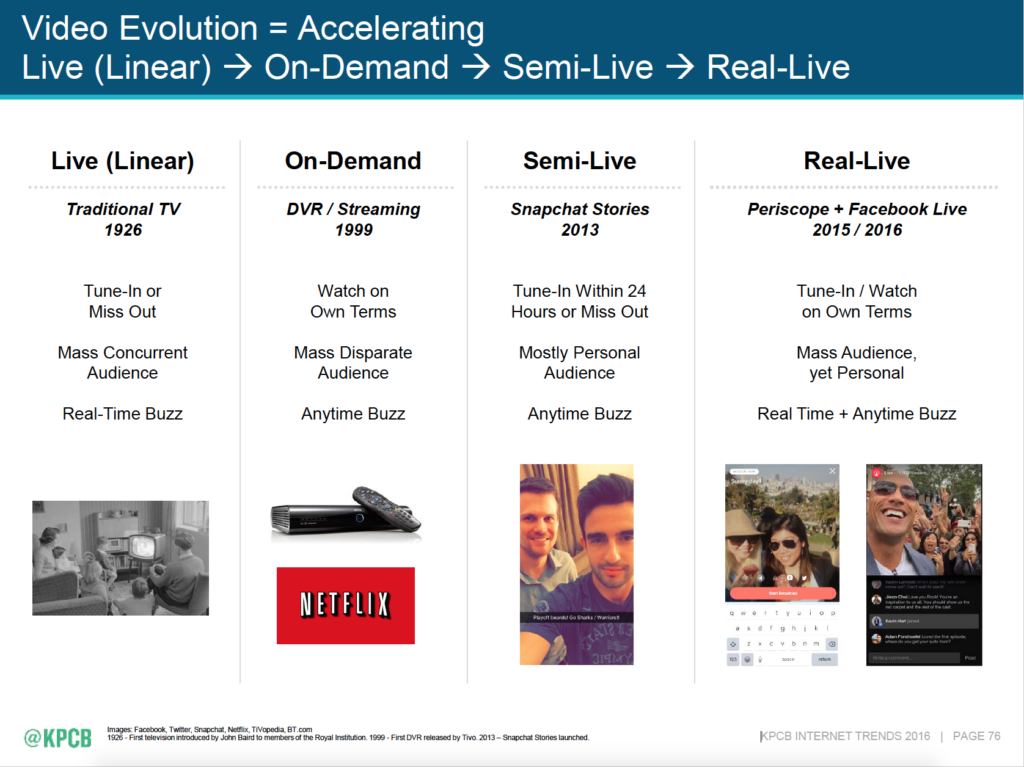
Video is evolving to combine the control of video on-demand and direct communication to mass audiences and live broadcasts
People are still sharing images and this is still the strongest (for the time being) and this is lead by SnapChat. Users are building their own new revenue streams on apps like SnapChat and Instagram where those with a large following and a specific niche are being offered money to promote a good or service.
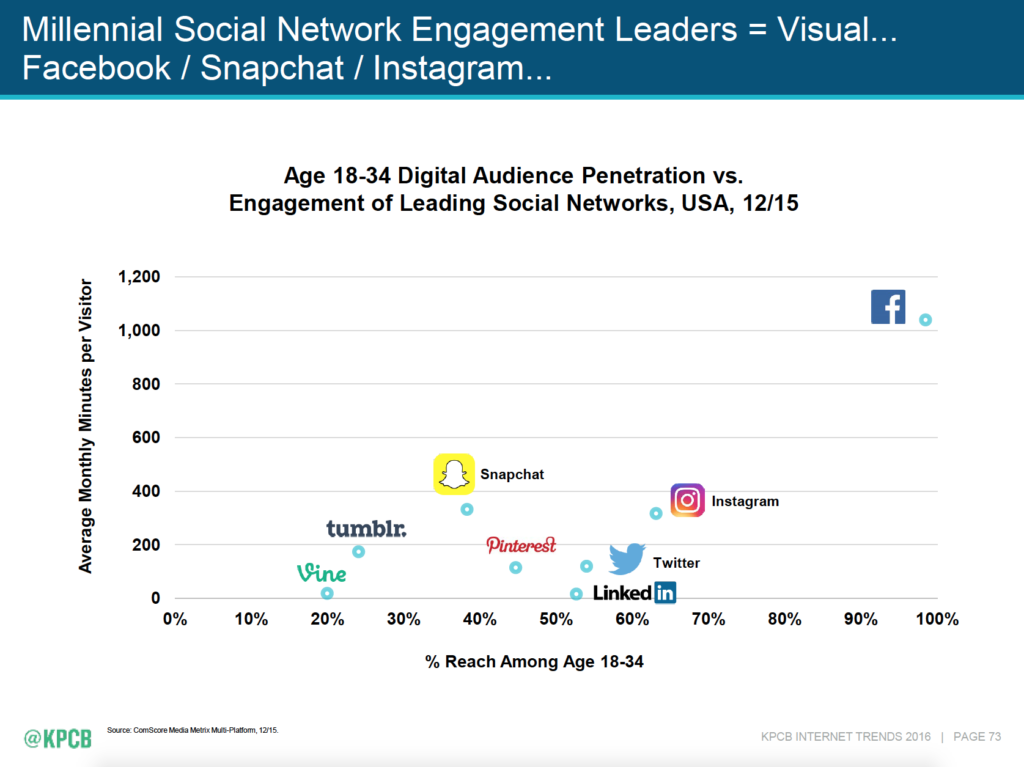
Social Network Engagement
Messaging is dominated by Facebook and WeChat (for China) and this is growing rapidly with apps like WhatsApp which have made Comms giants like Telstra and Optus lose out big on text messaging.
A huge prediction is being observed by Mary Meeker in the rise of voice search, with Google noting that more than 20% of searches are no longer text based.Google and Facebook now control about 76% of the advertising market, but its also clear that there is still too much being spent on legacy advertising for far less effect. There is a clear advantage for the early adopters to move into the digital advertising space, gaining the first mover advantage. In addition to this, there is further opportunity for mobile advertising with desktop ad-blocking up by 96% and this is led by China and India. Advertisers need to make their advertising more entertaining and less intrusive or risk offending their audience.
The United States being the once giant of the auto industry is set to possibly make a resurgence in the innovation with Tesla, Google and Apple all working heavily on telematics and vehicular automation and their homegrown business for car-sharing/pooling Uber and Uberpool being set to becomg a booming global business. With the emergence of voice as a more dependable interface lead by Apple Siri and Android’s offering, the combination of these in to cars will certainly become a more used method of controlling devices while driving. See our Chandler, Arizona, limousine service right here. that uses this feature which is being enjoyed by all the clients after using them.
Generational group Millennials are no longer just an age group, they are a force with a unique set of values and with a bigger focus on work-life balance, self-development and community contribution. Their purchasing power is set to become a major force with most of them expecting to be millionaires earlier in their lives and less interested in property ownership.
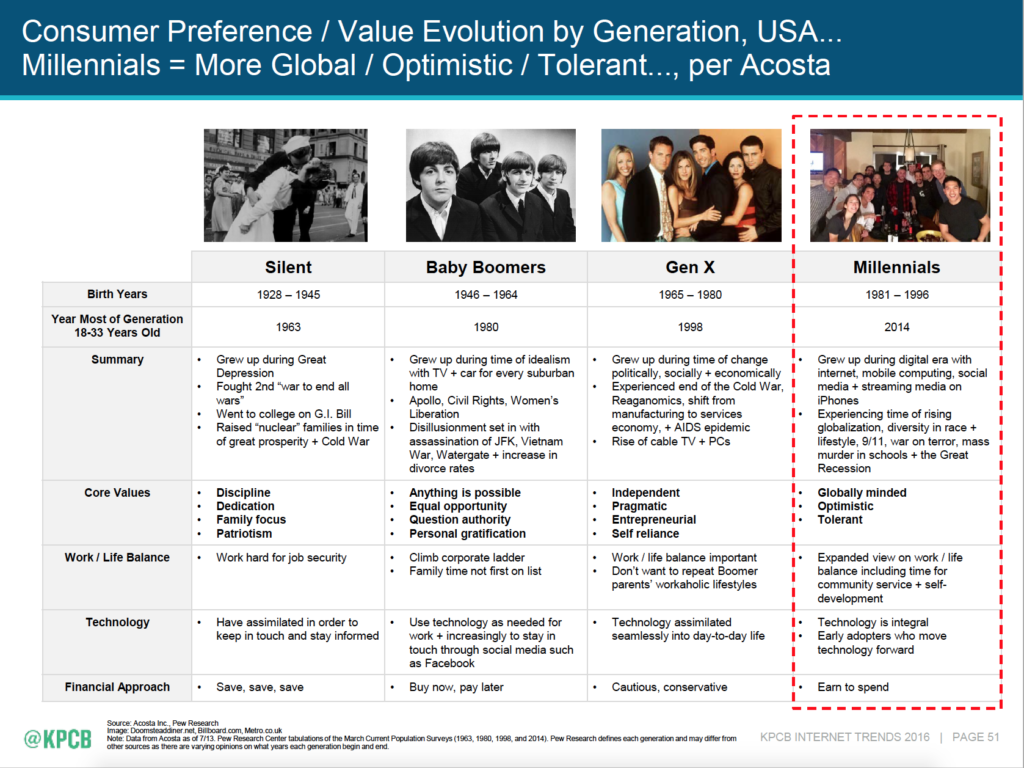
Consumer preference/value evolution by generation. Millenials more global, optimistic and tolerant.
The emerging Generation z cares more aboutuser experience, ease, personalisation and aligned values when compared to millenials who focus on price and comprehensiveness. This is a major insight for organisations wanting to target these markets are are spending up on UX design. While there is clearly a place for the money being spent on UX, other research suggesting people to be careful are indeed correct when stating that it is potentially at the expense of other market segments.
The internet enabled physical brands is again on the rise with Apple being named the most successful combination. Australian stores such as JB HiFi are really taking these combinations to the next level leaving a clear opportunity for stores like Myer and David Jones if they can develop their omni-channel approach.
Non-tech companies have changed their tech investment strategies by purchasing tech companies as a means to accelerate their technology innovation. Particularly the big consulting companies and investment bankers who have invested in data mining companies, analytics and cloud applications as a means to facilitate their plans to supply a range of services to businesses.
As devices to generate data are increasing rapidly (Apple TV, gaming devices, mobile computers fitbits, social applications and cars themselves) the third wave of data management is becoming even a bigger one that the previous. Data is becoming more powerful than ever and the new tools are giving more people in organisations the ability to make data driven decisions. Cloud platforms such as Salesforce are very quickly moving these activities from the CIO’s office and into the business. CIO’s must either become the enablers of this and facilitate, or the business, armed with a credit car will be able to do it themselves. Applications such as SalesforceIQ are user friendly, easy to set up and deliver major results in analytics to place businesses way ahead in this part of the game but they are not without their challengers such as DataDog which is a cheaper alternative, easier again but of course not as configurable, it does nevertheless provide a leapfrog approach for the business that wants to get in and get started quickly.

Evolution of the data platform
Data security using network incident detection tools was also earmarked as a major focus as businesses start to operationalise their API’s and make them available for partners and customers. With the ‘opening of the gates’, it becomes imperative that businesses lock down their security or risk bigger problems.
There is a stack of data in the presentation which will help any business cases in technology and they are well sourced. It pays to have a good read through and if you find other insights I missed, please leave a comment.
The post 2016 Internet Trends and Mary Meeker appeared first on The Digital Journal.
]]>The post Insurance Innovation in Australia appeared first on The Digital Journal.
]]>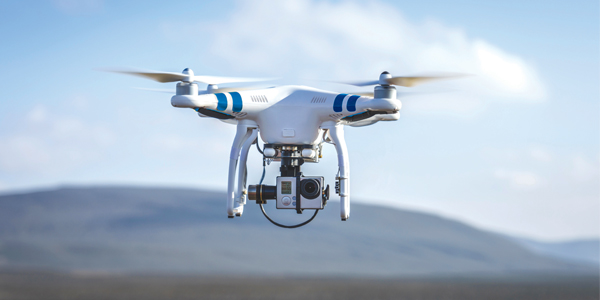
Drones making the assessment processes faster and easier
With each new tech gadget, such as Drones, wearable tech, the internet of things and connected cars consumers are expecting these elements to become a part of all their products. For more than 20 years, insurers offered a ‘pay as you drive’ policy either through a discount applied to low kilometres, or for products aimed at a market that is known for short drives such as APIA, which underwrote the risk based on the low km’s driven each year. We recently saw insurers starting to make claims assessments using drones which dramatically decreases the assessment time period for looking at the claim and obtaining real footage of that claim (although I know of one insurer that will do that, but still mail the cheque rather than deposit the funds). Insurers are already starting to assess the risk and conduct survey assessments using drones as well.

Connected homes offering better monitoring of your house.
Consumers are naturally expecting the concept of a connected home, which has better monitoring facilities in place to be able to provide a different risk profile, particularly in terms of incidents such as burglaries and fires. You can start here to learn about what are the best fire preventive methods that can be installed in every home. Knowing about this is essential because a monitored home will likely have a faster response time, but in terms of a burglary – there can be better information to mitigate or reduce loss and make assessments. The smart home ecosystems are set to drive major change in the insurance industry for consumers.
Vehicles that are connected and smart are really set to shake up the car insurance industry. The new telematics approaches are enabling a degree of knowledge around the car that includes not just the speed and kilometres, but how you drive, where, when the type of traffic right down to the individuals driving behaviours. While that might sound like an ideal way for an insurer to avoid a claim, and this is a typical response of a distrustful generation x’er, its the new millenials that are quite happy to share data about themselves, especially if it means they will get a better deal. The pay as you drive will soon really start to take hold in ways we thought were still a long way off. Some European countries such as Italy for example are already seeing telematic based insurers secure mor than 15% of the market through thier innovative approachs.
Cloud Computing has really started to revolutionise the industry in ways that only the futurists really thought was going to happen. The offerings of new, faster, cheaper and ‘on demand’ cloud technologies that include infrastructure, software and platforms can literally be started within the day (sometimes minutes). What this means to insurers is that development environments for new projects just got cheaper, faster and easier to procure. Testing environments as well and these can be placed on hold when not being used. These features mean that the technology is getting easier and more manageable (in terms of cost and complexity) thus moving IT out of the hard basket and enabling the business to focus on the next waves of innovation.
A ‘proof of concept’ is not a major investment anymore and advanced businesses such as SalesForce are offering out of the box applications that can substantally advance a business initiative in terms of product, marketing and customer management platforms leaving the next steps open to customisation, improvements and deployments. The same goes for ‘big data’ where the insurers are able to conduct their analytics and actuarial analysis – the computing power is now faster and cheaper and this trend is set to continue.
Mobile devices such as smartphones have impacted just about everything we do today from purchasing behaviours to engaging with our lives and managing those things that would take far too long. From simple policy management via a smartphone (something that is still taking many companies far too long) through to making some real variations on your contract its only a matter of time before customers can make that extra change on a policy when they are either heading out of town on holidays, or leaving the home for a week or more.
The post Insurance Innovation in Australia appeared first on The Digital Journal.
]]>The post Cloud Computing is not all the same appeared first on The Digital Journal.
]]>There are essentially three main areas of cloud computing that are gaining the most focus on enterprises, and these are: Infrastructure as a Services (IaaS), Platform as a service (PaaS) and Software as a Service (SaaS). The vendors in each space have a very different set of offerings, although they do start to cross over into the other services. It is crucial that an understanding of each is achieved in order to make the right decisions.
The National Institute of Standards and Technology defines cloud computing as a model for enabling convenient, on-demand network access to a shared pool of computing resources (networks, storage, applications and services) that can be rapidly deployed with minimal management and effort. These services include:
- On demand self-service, for a user to sign up without long delays;
- Broad network access to services via standard platforms (desktop, laptop and mobile);
- Resource pooling across multiple customers;
- Rapid elasticity to scale and cope with demand peaks;
- Measured services that are metered, billed and delivered as a utility service.
Initially, vendors provided services across specific platforms, however this has changed over the last few years and have commenced offering services on two or all three.

Cloud Platforms
Software as a Service (SaaS)
A provider of SaaS products will deploy access to the software via the internet and charge a licence to customers for access to that application through a subscription in a pay-as-you-go model. This is one of the fastest growing segments of the cloud market with more organisations offering services each year. Some of the defining characteristics of SaaS include:
- Web access to commercial software;
- Software is managed from a central location;
- Software is delivered in a one-to-many model;
- Users are not required to handle software upgrades and patches; and
- Application Programming Interfaces (API’s) allow for easy integration between different pieces of software.
Platform as a Service (PaaS)
The PaaS model brings the benefits that SaaS brought for applications in to the software development world. PaaS is a computing platform that allows the creation of web based applications quickly and easily and without the complexity of buying and maintaining the software and infrastructure underneath it. The concept is analogous to SaaS except that, rather than the software being delivered over the web, it is a platform for the creation of software delivered over the web. PaaS has a number of characteristics which include:
- Services to develop, test, deploy, host and maintain applications in the same integrated development environment. All the varying services need to fulfil the application development process;
- Web based user interface tools to create, modify, test and deploy different UI scenarios;
- Multi-tennanted architecture where concurrent users utilise the same development application;
- Built in scalability of deployed software including load balancing and failover;
- Integration with web services and databases via common standards
- Support for development team collaboration – Some PaaS solutions include project planning and communication tools;
- Tools to handle billing and subscription management; and
- Recently, more PaaS providers have opened marketplaces to take advantage of pre-developed software that can either be customised, enhanced and deployed, or is ready to be deployed. Examples of this include the Amazon Web Services marketplace, SalesForce marketplace and IBM BlueMix.
Infrastructure as a Service (IaaS)
IaaS is a way of delivering cloud computing infrastructure – servers, storage, network and operating systems as an on demand service. Rather than purchasing servers, operating software, datacentre space or network equipment clients can purchase these resources as a fully outsourced service. IaaS can be obtained as a public (shared resources deployed on a self-service basis via the internet) or private cloud (emulates ‘cloud-like’ features on a private network). A hybrid cloud combines traditional dedicated hosting alongside a public and/or private cloud. IaaS usually includes the following characteristics:
- Resources are distributed as a service;
- Allows for dynamic scaling;
- Has a variable cost, utility pricing model; and
- Generally, includes multiple users on a single piece of hardware.
The post Cloud Computing is not all the same appeared first on The Digital Journal.
]]>